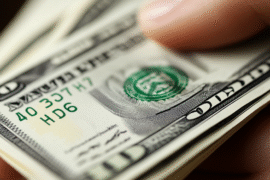This article may contain references to products or services from one or more of our advertisers or partners. We may receive compensation when you click on links to those products or services. Nonetheless, our opinions are our own.
The information presented in this article is accurate to the best of our knowledge at the time of publication. However, information is subject to change, and no guarantees are made about the continued accuracy or completeness of this content after its publication date.
- How the U.S. Dollar Rose to Global Reserve Currency Status
- Historical Foundations of the Dollar’s Dominance
- Expansion Through Global Trade and Financial Networks
- Impact of U.S. Stability on Monetary Influence
- Strategic Financial Considerations for Dollar-Linked Economies
- Emerging Trends and Potential Disruptions
- Conclusion
- Frequently Asked Questions
- Recommended Reads
How the U.S. Dollar Rose to Global Reserve Currency Status
The U.S. dollar is at the center of international finance. Its power affects countries, markets, and decades. It is not a coincidence that it is so well-known; it is the result of a carefully planned legacy created by economic resilience, strategic policy, and global realignment after global conflict. This study looks at the factors that made the dollar the most important currency in financial systems and what that means for the world’s economies.
Historical Foundations of the Dollar’s Dominance
The Bretton Woods Accord and Post-War Recovery
Following the devastation of World War II, world economies required a new framework to stabilize currencies and rebuild trust in monetary systems. In 1944, delegates from 44 nations gathered at the Bretton Woods Conference in New Hampshire to establish a cooperative economic structure. The result was a fixed exchange rate regime where participating currencies were pegged to the U.S. dollar, which itself was tied to gold at $35 per ounce. This decision was not arbitrary. By the mid-20th century, the United States had amassed the largest gold reserves, boasted unmatched industrial output, and had escaped the physical destruction endured by other nations. These advantages gave the dollar unparalleled credibility as a reserve asset.
Factors Behind Widespread Adoption
Several circumstances aligned to elevate the dollar’s status:
- Economic strength: The U.S. emerged with a thriving manufacturing sector and intact infrastructure, allowing it to dominate post-war global trade.
- Monetary reliability: The dollar’s convertibility into gold reassured foreign governments and central banks about its stability.
- Political continuity: Compared to war-torn or regime-shifting regions, the U.S. offered predictable governance, enhancing trust in long-term obligations.
As nations rebuilt their economies, the dollar became a primary vehicle for international reserves and settlement of trade.
Expansion Through Global Trade and Financial Networks
The Dollar as the Preferred Medium for Exchange
As international trade flourished through the 20th century, businesses and central banks gravitated toward the dollar. Its widespread use became self-reinforcing: the more countries adopted it for transactions, the more others followed to avoid the inefficiencies of currency conversion.
Factors that reinforced this adoption include:
- Liquidity: Deep and well-regulated U.S. capital markets enabled easy exchange and movement of dollar-denominated assets.
- Global accessibility: The dollar became the unit of account for commodities, including oil and gold, further embedding its role in international pricing.
- Confidence in U.S. institutions: Stable monetary policy and legal enforcement in the United States provided assurance that dollar assets would retain value.
The dollar makes up around 60% of declared foreign exchange reserves, far more than the euro, yen, and pound sterling, according to recent data from the International Monetary Fund.
| Currency | Share of Global Reserves (%) |
|---|---|
| U.S. Dollar | 60 |
| Euro | 20 |
| Japanese Yen | 6 |
| British Pound | 5 |
| Other Currencies | 9 |
These figures underscore the embedded role of the dollar not only in central bank reserves but also in institutional portfolios, cross-border contracts, and sovereign debt issuance.
Voted "Best Overall Budgeting App" by Forbes and WSJ
Monarch Money helps you budget, track spending, set goals, and plan your financial future—all in one app.
Get 50% OFF your first year with code MONARCHVIP
Impact of U.S. Stability on Monetary Influence

Institutional and Macroeconomic Trust
The enduring strength of the dollar is inseparable from the stability of the United States. Predictable fiscal governance, transparency in central banking, and the rule of law form the foundation of trust for international holders of dollar-denominated assets.
Implications of this stability include:
- Investment attraction: Steady legal protections and consistent economic policies make U.S. assets attractive to foreign investors.
- Reduced volatility: In times of geopolitical tension or financial uncertainty, the dollar often strengthens as investors seek safety.
- Policy leverage: The central role of the dollar enables the U.S. to wield influence through sanctions and monetary policy transmission.
Strategic Financial Considerations for Dollar-Linked Economies
Portfolio Positioning
Global investors and institutions often use the dollar’s strength as a reference point in financial planning. Diversification into dollar-denominated assets can act as a hedge against regional instability and currency depreciation.
| Asset Type | Benefits | Considerations |
|---|---|---|
| U.S. Treasuries | High liquidity, low default risk | Vulnerable to interest rate shifts |
| International Equities | Diversification, growth exposure | Subject to exchange rate volatility |
| Dollar Debt Instruments | Predictable repayment structure | May limit return potential |
Debt Management and Currency Risk
For borrowers in emerging markets, holding debt in dollars can reduce financing costs but introduces risk if their local currencies depreciate. As such, timing and hedging become important tools in managing these obligations.
Emerging Trends and Potential Disruptions
Digital Currencies and Technological Disruption
Recent developments in digital assets and central bank-issued digital currencies have begun to question the durability of traditional currency structures. While the dollar currently faces no serious competitor in scale or trust, future shifts are plausible.
| Trend | Possible Impact |
|---|---|
| Central Bank Digital Currencies | Faster settlement, reduced transaction costs |
| Blockchain-Based Assets | Alternative store of value, borderless transfers |
| Economic Alliances | May encourage regional diversification of reserves |
The outcome of these developments depends on adoption, regulation, and whether new systems can replicate the security and scale of the current U.S.-anchored framework.
Conclusion
The rise of the U.S. dollar as the dominant reserve currency is the result of historical circumstance, economic leadership, and institutional trust. While evolving technologies and shifting geopolitical landscapes may shape the future of currency usage, the dollar remains deeply embedded in the architecture of modern global finance. Whether as a tool for investment, trade, or policy leverage, its influence continues to define the financial order of the 21st century.
Frequently Asked Questions
What is a reserve currency?
A reserve currency is a currency held by central banks and financial institutions in large quantities to facilitate international trade, investment, and exchange rate management.
When did the dollar begin to dominate globally?
The dollar’s dominance began post-World War II, particularly after the 1944 Bretton Woods Agreement, which formalized its role as the reference point for most global currencies.
Why did gold backing matter?
Linking the dollar to gold created a tangible standard that reassured other nations of its value, promoting widespread adoption and trust.
What changed in the 1970s?
In 1971, President Nixon suspended the dollar’s convertibility into gold, ending the Bretton Woods system. This marked the transition to fiat currencies. Despite this, the dollar retained its reserve status due to confidence in the U.S. economy and institutions.
Do other currencies compete with the dollar?
While the euro, yen, and Chinese yuan have grown in use, none have yet matched the dollar’s combination of liquidity, reliability, and scale in global finance.

Reviewed and edited by Albert Fang.
See a typo or want to suggest an edit/revision to the content? Use the contact us form to provide feedback.
At FangWallet, we value editorial integrity and open collaboration in curating quality content for readers to enjoy. Much appreciated for the assist.
Did you like our article and find it insightful? We encourage sharing the article link with family and friends to benefit as well - better yet, sharing on social media. Thank you for the support! 🍉
Article Title: How the Dollar Became the World’s Reserve Currency
https://fangwallet.com/2025/08/05/how-the-dollar-became-the-worlds-reserve-currency/The FangWallet Promise
FangWallet is an editorially independent resource - founded on breaking down challenging financial concepts for anyone to understand since 2014. While we adhere to editorial integrity, note that this post may contain references to products from our partners.
The FangWallet promise is always to have your best interest in mind and be transparent and honest about the financial picture.
Become an Insider

Subscribe to get a free daily budget planner printable to help get your money on track!
Make passive money the right way. No spam.
Editorial Disclaimer: The editorial content on this page is not provided by any of the companies mentioned. The opinions expressed here are the author's alone.
The content of this website is for informational purposes only and does not represent investment advice, or an offer or solicitation to buy or sell any security, investment, or product. Investors are encouraged to do their own due diligence, and, if necessary, consult professional advising before making any investment decisions. Investing involves a high degree of risk, and financial losses may occur including the potential loss of principal.
Source Citation References:
+ Inspo
Best, R. (2016). How the US Dollar Became the World's Reserve Currency. Investopedia. com.












































